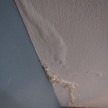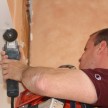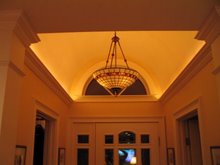Repairing Ice Dam Damage
Dealing with loose wallboard or sagging ceilings:
If the ceiling is sagging or the wall moves when you gently push on it you may have a fastener failure, or rotted framing? A small inspection hole can help determine if there is rot or simply rusted screws or nails.
If a fastener failure, reattached the plaster to the stud or lath by using long drywall screws fitted with plaster washers.
Plaster washers, also known as ceiling buttons, are metal washers with a series of holes to hold drywall compound and are designed to increase the surface area of a screw head to avoid punching the screw through the plaster and also to provide holding power. Mot hardware stores carry these washers, I get mine at Concord Lumber Corp.
To avoid cracking the plaster and creating more damage, install a few washers around the crack or across the sagged area and drive them snug against the plaster face. Then tighten each of them slowly, moving from one to another, so that the plaster gradually pulls tight against the lath.
Make sure NOT to overdrive your screws – your looking for a secure, snug attachment. You also want to gently work the sag back into place, by starting on one end and working to the other, or the center and working out to the sides.
Cover seams, cracks and plaster buttons with mesh tape
Go over the surface with vacuum brush to remove any loose particles. Wash the surrounding surfaces using a sponge and bucket of clean water to remove any residual lime deposits, allow the plaster to dry completely before proceeding.
Apply mesh drywall tape over all seams, any plaster washers and cracks. Cracks are best covered with mesh tape or they will come back.
Apply Drywall Compound “mudding”
Apply series of drywall compound patch in layers over all of your apes areas and and damaged holes.
According to my friend and painter Dan Frost, fro Frost Painting, “ If the plaster has come off to reveal the Sheetrock” (gray color) he applies a coat of USG Sheetrock Brand Lightweight Setting-Type Joint Compound, called Durabond 20 (durobond.com) for a base coat. The “20” means 20-minute dry time.
Dan says, “Keep a wet sponge handy to wipe smooth the Dura bond after you apply the first coat taking the excess off with a wet 6 inch drywall blade.”
Dan cautions that, “multiple thin coats and patience are key.” After the first coat, if done smooth and properly, no sanding is necessary, a second coat is applied using Durabond EasySand 20. This is a lighter joint compound that sands easy. Once the patched is built up to the level of the surface you are all set to lightly sand with 220 grit sandpaper.
With each coat of drywall compound you want to “feathering out” further away from the repair from 4” to 6” to 8” or 12” depending on the size of the crack.
Repair shallow surface damage using several thin coats of joint compound to fill in the missing plaster, and level out the wall. Cover the whole damaged area and surrounding wall with a ¼ inch coat.
Use a flexible knife to “butter” the area like a piece of toast and then immediately go back and skim off the extra mud, using parallel strokes from one side to the other.
Float the blade across the deeper damage to fill it in and skim harder on the surrounding walls to leave a very thin coat. Don’t let mud build up higher over the repair area than it is on the surrounding surfaces.
Ignore any ridges left by the knife blade or other inconsistencies in the surface, when the mud has set you can scrape them off with your putty knife before applying another coat. Scraping between coats saves a lot of sanding effort!
Allow enough dry time in between each pass.




















